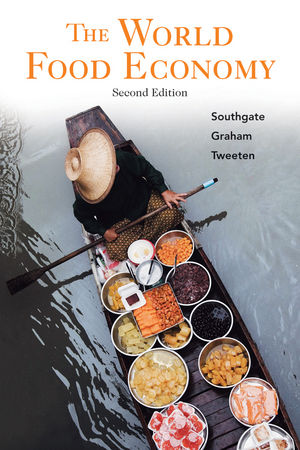|
Textbook
The World Food Economy, 2nd EditionISBN: 978-0-470-59362-2
Paperback
464 pages
December 2010, ©2011
 |
||||||
Acknowledgments.
1 Introduction.
1.1 Our Focus.
1.2 Chapter Outline.
Key Words and Terms.
Study Questions
2 The Demand Side: How Population Growth and Higher Incomes Affect Food Consumption.
2.1 Classic Malthusianism, Its Modern Variants, and Its Critiques.
2.2 Demographic Transition.
2.3 Trends in Human Numbers, Past and Present.
2.4 Food Consumption and Income.
2.5 Demand Trends and Projections.
2.6 Summary and Conclusions.
Key Words and Terms.
Study Questions.
Appendix: The Fundamental Economics of Demand.
3 The Supply Side: Agricultural Production and Its Determinants.
3.1 The Nature of Agriculture.
3.2 Increases in Agricultural Supply.
3.3 Has Intensification Run Its Course?
3.4 The Food Economy Beyond the Farm Gate.
3.5 Trends in Per Capita Production.
Key Words and Terms.
Study Questions.
Appendix: The Fundamental Economics of Supply.
4 Aligning the Consumption and Production of Food over Time.
4.1 The Desirability of Competitive Equilibrium.
4.2 Public Policy and Markets for Farm Products.
4.3 Historical Trends in the Scarcity of Agricultural Products.
4.4 Outlook for the Twenty-First Century.
Key Words and Terms.
Study Questions.
Appendix: The Coordination of Decentralized Decision Making.
5 Agriculture and the Environment.
5.1 Diagnosing and Correcting Environmental Market Failure.
5.2 Agriculture and Climate Change.
5.3 Farmland Degradation.
5.4 Agriculture and Deforestation.
5.5 Agricultural Development and the Environment.
Key Words and Terms.
Study Questions.
Appendix: Market Failure and Its Remedies.
6 Globalization and Agriculture.
6.1 The Theory of Comparative Advantage.
6.2 Trade Distortions and the Economic Impacts.
6.3 The Debate over Globalization.
6.4 Potential Gains from Agricultural Trade Liberalization.
6.5 Multilateral Trade Negotiations and Agriculture.
6.6 The Case for Free Trade Still Stands.
Key Words and Terms.
Study Questions.
Appendix: Two-Country Illustrations of Comparative Advantage.
7 Agriculture and Economic Development.
7.1 Economic Expansion and Structural Transformation.
7.2 Agriculture's Role in Economic Development.
7.3 Trying to Develop at Agriculture's Expense.
7.4 Agricultural Development for the Sake of Economic Growth and Diversification.
7.5 Summary and Conclusions.
Key Words and Terms.
Study Questions.
8 Striving for Food Security.
8.1 Who and Where Are the Food-Insecure?
8.2 Achieving Food Security.
8.3 The Food Security Synthesis and Economic Development.
8.4 The Standard Model and Communitarian Values.
Key Words and Terms.
Study Questions.
9 Inter-Regional Differences and Similarities.
9.1 Economic Growth and Income Distribution.
9.2 Population Dynamics.
9.3 Agriculture's Response to Demand Growth.
9.4 Summary.
Key Words and Terms.
Study Questions.
10 Affluent Nations.
10.1 Standards of Living.
10.2 Population Dynamics.
10.3 The Food Economy.
10.4 Dietary Change and Consumption Trends.
10.5 Summary.
Key Words and Terms.
Study Questions.
11 Asia.
11.1 Trends in GDP per Capita.
11.2 Population Dynamics.
11.3 Agricultural Development.
11.4 Dietary Change, Consumption Trends, and Food Security.
11.5 Summary.
Key Words and Terms.
Study Questions.
12 Latin America and the Caribbean.
12.1 Trends in GDP per Capita.
12.2 Population Dynamics.
12.3 Agricultural Development.
12.4 Dietary Change, Consumption Trends, and Food Security.
12.5 Summary.
Key Words and Terms.
Study Questions.
13 The Middle East and North Africa.
13.1 Political Realities and Economic Trends.
13.2 Population Dynamics.
13.3 Agricultural Development.
13.4 Dietary Change, Consumption Trends, and Food Security.
13.5 Summary.
Key Words and Terms.
Study Questions.
14 Eastern Europe and the Former Soviet Union.
14.1 Economic Trends since the Fall of Communism.
14.2 Demographic Trends.
14.3 The Agricultural Sector.
14.4 Dietary Change, Consumption Trends, and Food Security.
14.5 Summary.
Key Words and Terms.
Study Questions.
15 Sub-Saharan Africa.
15.1 Trends in GDP per Capita.
15.2 Demographic Trends.
15.3 Agricultural Development.
15.4 Consumption Trends and Food Security.
15.5 Summary.
Key Words and Terms.
Study Questions.
16 The Global Food Economy in the Twenty-First Century.
16.1 Victims of Our Own Success?
16.2 The New Food Economy.
16.3 The Changing Role of Government.
16.4 Back to the Future Food Economy?
Key Words and Terms.
Study Questions.
Abbreviations and Acronyms.
Map Annex.
References.
Index.



